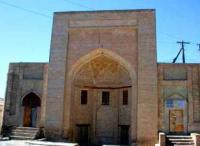Вы здесь
Kurpa mosque.

The historical guidebook across Bukhara.
“I've known rivers:
I've known rivers ancient as the world and older than the flow of human blood in human veins. My soul has grown deep like the rivers”
Langston Hughes.
Coach tour in Bukhara.
Kurpa Mosque is located in Bukhara and was constructed in XV century. Western passage of Taq-i Telpaq Furushon opens to the street Mekhtar Ambar. A little in front on the left, stands out the Kurpa Mosque in its un renewed grace.
Masters of Bukhara architectural school of XVI - XVII centuries used in construction and decoration of cheap and not labor, but efficient and efficient techniques. In the XVI century used in majolica decor colorful, sometimes monumental ancient zoroastrian images of zoroastrian subjects dominated the sun drawing flying birds.
The Kurpa Mosque is situated in the residential quarter, formerly called "Magoki Kurpa", i.e." Hollow of blanket(s' bazaar)". The two-storied structure of the Kurpa Mosque has a quite typical design.
However the mosque has one peculiarity. The lower floor, made for a cold spell in winter, is semi-basement. At first sight, an entrance to the lower floor does not give an intimation that it leads to a roomy premise of cathedral mosque.
It is exactly what the mosque initially was assigned to be. Until the Khoja Kalon Mosque was put into operation, the Kurpa mosque used to be a central cathedral mosque, no matter how small it was.
The Kurpa Mosque had tahorathona - a place for partial ablution, which, according to sharia law, should precede each prayer. The mosque was built before 1598 on initiative of Khoja Sa'ad - called "Khoja Kalon" - "Great Khoja", the son of Khoja Islam.
Named "Khoja Mosque" or "Khoja Kalon Mosque", with tall minaret close to the Gaukushan Madrasah. In addition to this information there is a narrative about builder or (an architect of the Kurpa Mosque), which was brought to the earth under the mihrab of the mosque.
This legend exists in spite of the fact that there are not any signs directing to the tomb. The city was built madrasah and mosques, including also a neighborhood mosque Kurpa. Magoki - Kurpa is located in the quarter, which was formerly called "Magoki Kurpa" that has a meaning "The depression at the bazaar blankets."
The mosque was built in the 1637 building, is located in the historic center of Bukhara, close to a shopping dome Telpak Furushon and is one of two "underground" ( Magoki ) osques.
Authority and photos:
Dmitriy Page. The Guide to Bukhara. History and sights. http://www.pagetour.org







